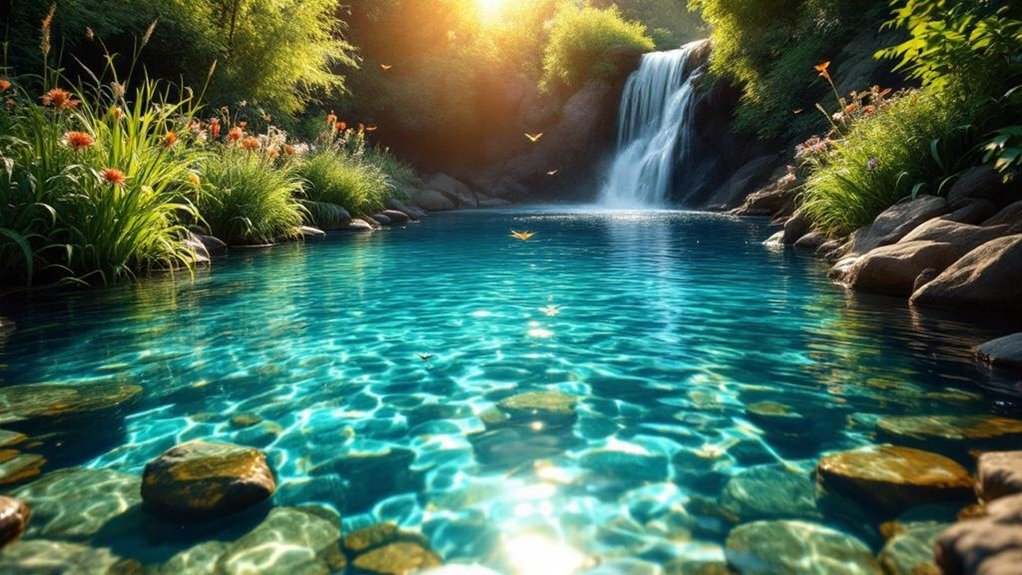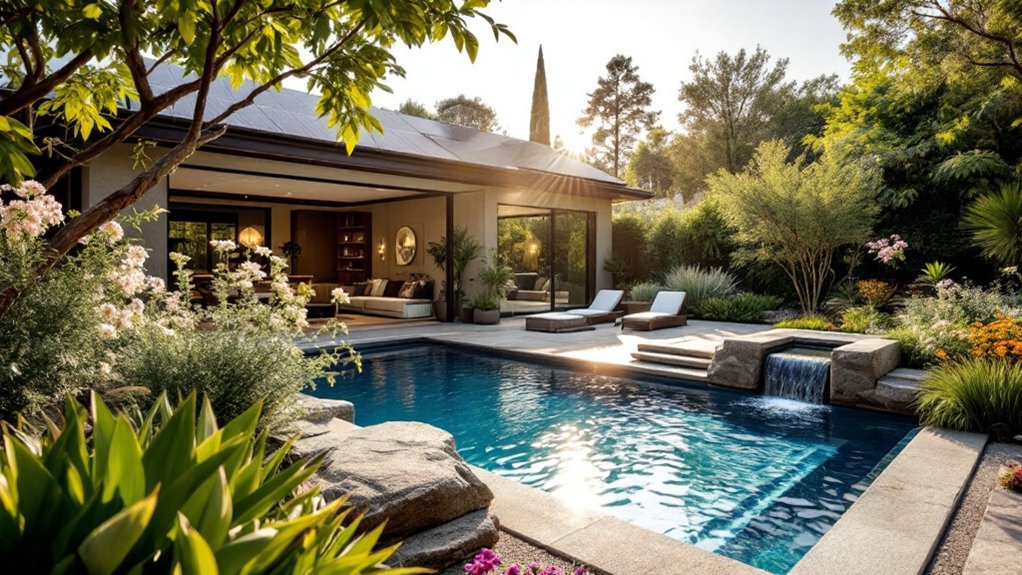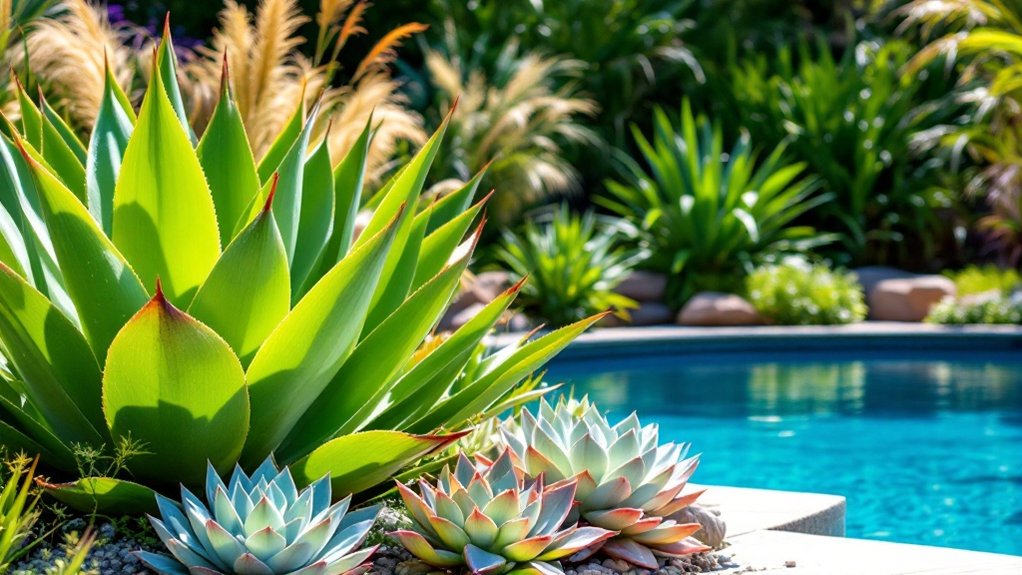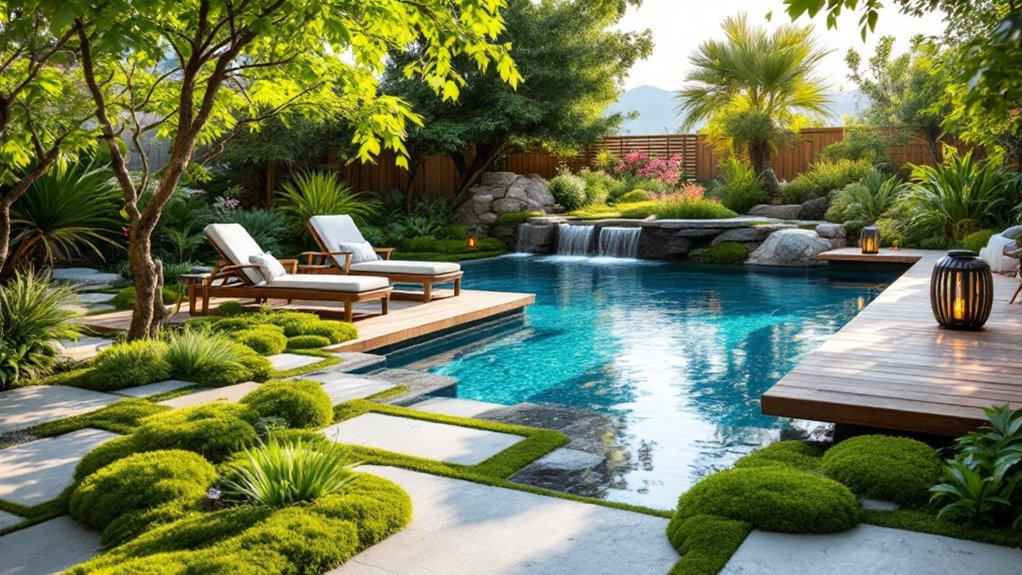Natural pools present a unique approach to sustainable swimming. They function through biological filtration, utilizing plants and microorganisms to maintain clean water without chemicals. This method not only fosters a self-sustaining ecosystem but also enhances local biodiversity. The aesthetic integration of these pools into natural landscapes raises questions about their design and maintenance. What are the essential elements that make a natural pool both functional and visually appealing?
Understanding Natural Pools: How They Work
Natural pools operate on a unique principle that distinguishes them from traditional swimming pools. Instead of relying on chemical treatments, these pools utilize a biological filtration system, integrating plants and microorganisms to maintain water clarity and quality. The design typically includes two zones: a swimming area and a regeneration zone. In the regeneration zone, aquatic plants thrive, absorbing nutrients and filtering impurities from the water. This natural ecosystem works harmoniously to create a self-sustaining environment. Water circulates between the two zones, with the regeneration area providing the necessary filtration to keep the swimming area clean and safe. As a result, swimmers enjoy a chemical-free experience, immersed in a more natural setting that mimics freshwater ecosystems.
Environmental Benefits of Natural Pools
Natural pools offer significant environmental advantages through their chemical-free water systems, reducing the need for harmful substances often found in conventional pools. This approach not only promotes healthier swimming experiences but also supports local ecosystems by enhancing biodiversity. By creating natural habitats, these pools contribute positively to the surrounding environment.
Chemical-Free Water Systems
Chemical-free water systems in pools offer a sustainable alternative to traditional chlorinated options, promoting both environmental health and personal well-being. These systems utilize natural filtration methods, such as plants and biological filters, to maintain water clarity and cleanliness without harmful chemicals. By eliminating chlorine, they reduce the risk of skin and respiratory irritations often associated with chemical treatments. In addition, chemical-free pools minimize the release of toxic substances into the environment, protecting local ecosystems and water sources. They also require less energy for maintenance, contributing to a lower carbon footprint. As awareness grows regarding the detrimental effects of chemical use, more pool owners are considering these eco-friendly systems, aligning recreational practices with environmental stewardship.
Biodiversity Enhancement Benefits
While many conventional pools prioritize aesthetics over ecological impact, natural pools greatly enhance local biodiversity. These ecosystems create habitats for various flora and fauna, promoting the growth of aquatic plants, amphibians, and insects. By incorporating native plants, natural pools contribute to the stabilization of local ecosystems, providing food and shelter for wildlife. This rich biodiversity not only supports species conservation but also improves water quality through natural filtration processes. Additionally, the presence of diverse organisms fosters a balanced ecosystem, reducing the reliance on chemical treatments. Ultimately, natural pools serve as crucial resources for ecological education and community engagement, encouraging individuals to appreciate and protect their local environments while enjoying sustainable swimming experiences.
Aesthetic Appeal: Designing Your Natural Oasis
Creating a natural pool involves careful consideration of aesthetic elements that enhance its beauty. Integrating natural features such as rocks and wood can harmonize the pool with its surroundings, while selecting the right plants adds vibrancy and life. This thoughtful design transforms the pool area into a serene oasis that invites relaxation and enjoyment.
Integrating Natural Elements
As homeowners seek to enhance their outdoor spaces, integrating natural elements into the design of a natural pool can markedly elevate its aesthetic appeal. The use of materials such as stone and wood can create a seamless connection between the pool and surrounding landscape. Incorporating boulders or pebbles not only adds texture but also mimics natural water bodies. The strategic placement of rocks can enhance visual interest while providing habitats for local wildlife. Water features like waterfalls or streams can introduce soothing sounds, enriching the sensory experience. Additionally, creating varying depths and shapes can evoke the organic forms found in nature, fostering a more inviting atmosphere. This thoughtful integration ultimately transforms the pool area into a tranquil, natural oasis.
Choosing the Right Plants
Selecting the appropriate plants plays a significant role in enhancing the beauty and functionality of a natural pool. A well-designed plant selection can create a harmonious balance between aesthetics and ecological health. Aquatic plants, such as water lilies and cattails, not only provide visual interest but also contribute to water purification and habitat creation. Marginal plants, like sedges and ferns, can soften the edges of the pool while stabilizing the banks and preventing erosion. Additionally, incorporating native species fosters biodiversity and supports local wildlife. Careful consideration of plant placement guarantees ideal light exposure and growth conditions. Ultimately, the right combination of plants transforms a natural pool into a serene oasis, inviting relaxation while promoting a sustainable ecosystem.
Key Components of a Natural Pool
A natural pool is defined by its harmonious blend of ecological elements designed to replicate a natural water body. Key components include a swimming zone, typically lined with a non-toxic material, and a regeneration zone, where aquatic plants and microorganisms filter and purify the water. The regeneration area often features gravel and sand substrates that support beneficial plant life, such as water lilies and reeds. Water circulation is essential, usually achieved through pumps or gravity systems, ensuring proper filtration and oxygenation. Additionally, natural pools may incorporate rocks and boulders, enhancing aesthetics while providing habitats for wildlife. Together, these elements create a self-sustaining ecosystem that balances beauty and functionality, offering a rejuvenating swimming experience without synthetic chemicals.
Maintenance Tips for Sustainable Swimming
While enjoying the serene environment of a natural pool, proper maintenance remains essential for preserving its ecological balance and ensuring a clean swimming experience. Regularly checking water levels and maintaining a consistent flow through filtration systems, such as gravel and plants, is vital. Removing debris, leaves, and algae prevents unwanted buildup that can disrupt the ecosystem. Monitoring water quality, including pH and nutrient levels, helps maintain a healthy environment for aquatic life. Additionally, seasonal tasks, such as pruning surrounding vegetation and managing invasive plant species, contribute to the pool’s overall health. Educating oneself about local fauna and flora can enhance the understanding of the ecosystem, fostering a deeper appreciation for the intricate balance of nature in sustainable swimming.
Cost Considerations: Investing in a Natural Pool
Investing in a natural pool involves careful financial planning and consideration of various factors beyond initial installation costs. While the upfront expenses can be significant, including excavation, landscaping, and plant selection, ongoing maintenance also warrants attention. Homeowners should factor in annual costs for water quality management, plant care, and occasional repairs. Additionally, energy-efficient systems can help mitigate long-term operational expenses. Potential savings on chemicals and lower water bills may offset some costs, making natural pools an appealing option for eco-conscious consumers. It is essential to evaluate the overall value and benefits, such as aesthetic appeal and environmental impact, when determining whether a natural pool aligns with one’s budget and lifestyle preferences.
Real-Life Examples of Beautiful Natural Pools
Natural pools can transform outdoor spaces into stunning retreats that seamlessly blend with their natural surroundings. One remarkable example is the natural swimming pond at the Weller Haus, located in Tennessee. Surrounded by lush greenery and native plants, it features clear water supported by a biofiltration system. Another stunning instance is found at the Casa de la Paz in Mexico, where an infinity natural pool overlooks the ocean, creating a picturesque view. In Europe, the natural pool at the Treetops Resort in Michigan showcases a rustic design with stone accents and vibrant aquatic life. These examples highlight the aesthetic and ecological benefits of natural pools, offering serene swimming experiences while harmonizing with the environment.
Frequently Asked Questions
Can Natural Pools Attract Wildlife Like Frogs and Birds?
The question of whether natural pools attract wildlife, such as frogs and birds, is significant. Observations indicate that these ecosystems often encourage diverse species, providing essential habitats and promoting biodiversity in surrounding environments.
Are There Specific Plants That Improve Water Quality in Natural Pools?
Certain aquatic plants, such as water lilies and cattails, markedly enhance water quality by absorbing nutrients and providing habitat for beneficial microorganisms. Their presence promotes a balanced ecosystem, essential for maintaining clear and healthy water conditions.
How Do Natural Pools Handle Winter Weather Conditions?
Natural pools manage winter weather by allowing water temperatures to stabilize, often utilizing insulation techniques. Ice formation is typically minimal, as the natural filtration system and plants help maintain ecological balance, ensuring overall health during cold months.
Can I Convert My Existing Pool Into a Natural Pool?
Converting an existing pool into a natural pool is feasible, but it requires careful planning and execution. Factors such as design, filtration systems, and plant selection must be considered to guarantee a successful transformation.
What Chemicals, if Any, Are Used in Natural Pools?
Natural pools typically utilize minimal chemicals, primarily relying on natural filtration systems. Some may add organic treatments for algae control or water clarity, but the focus remains on maintaining a balanced ecosystem without synthetic substances.
Conclusion
To summarize, natural pools represent a harmonious blend of sustainability, aesthetics, and functionality. By utilizing biological filtration systems and promoting local biodiversity, these eco-friendly alternatives provide a serene swimming experience without the use of harmful chemicals. As homeowners increasingly seek environmentally conscious options, the appeal of natural pools continues to grow, ensuring that they not only enhance personal enjoyment but also contribute positively to the surrounding ecosystem. Embracing this trend paves the way for a greener future in outdoor living.




